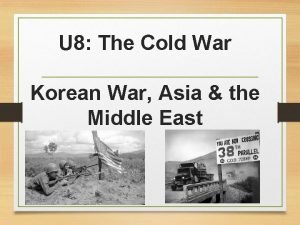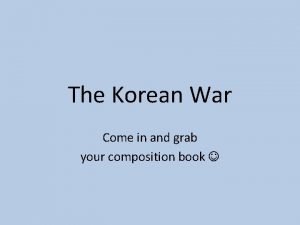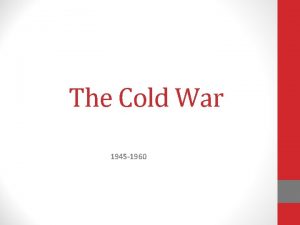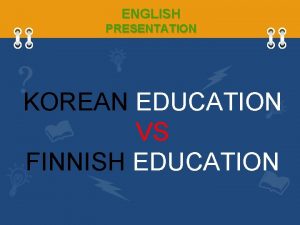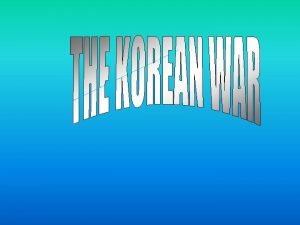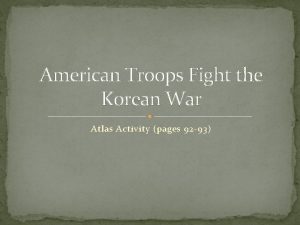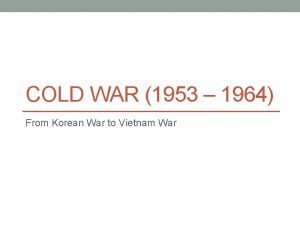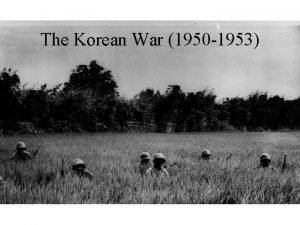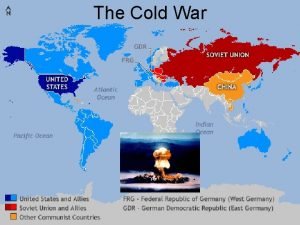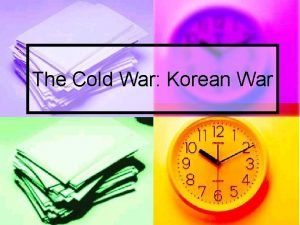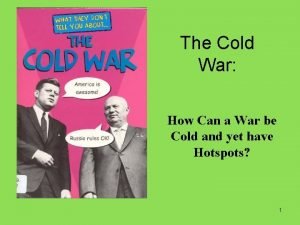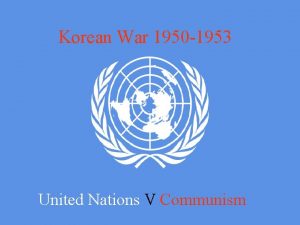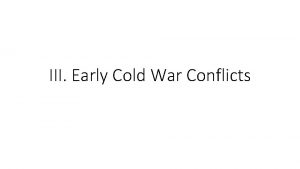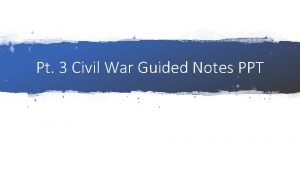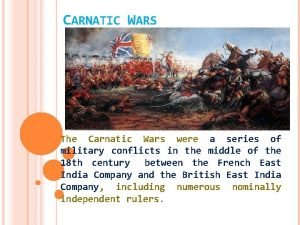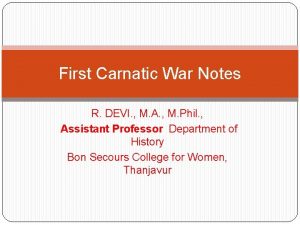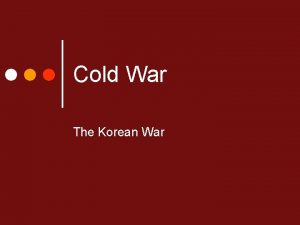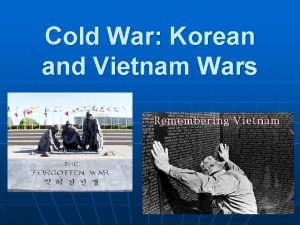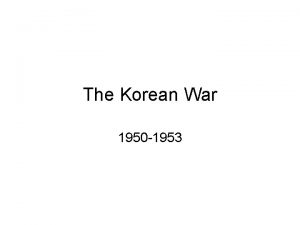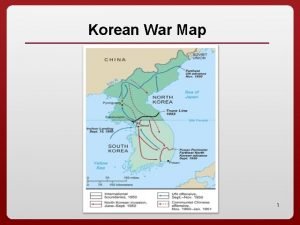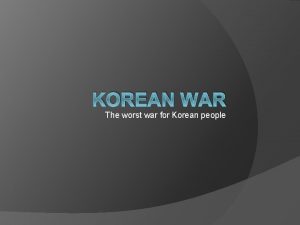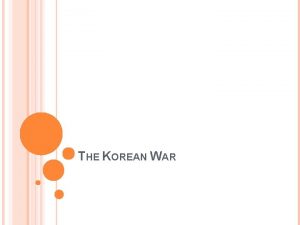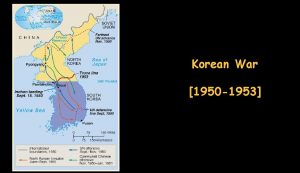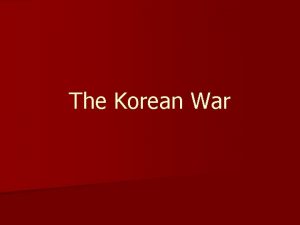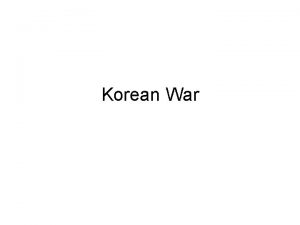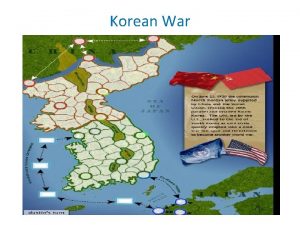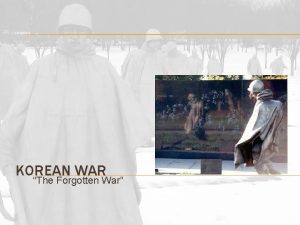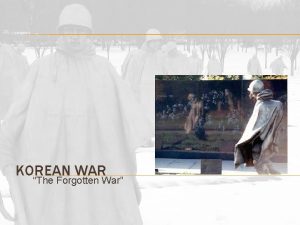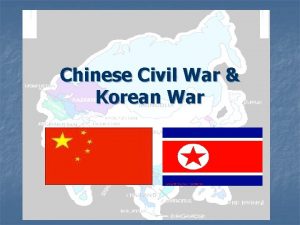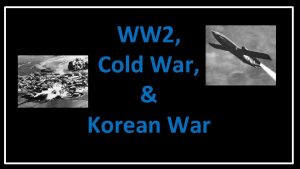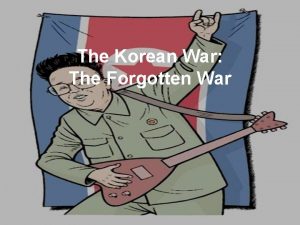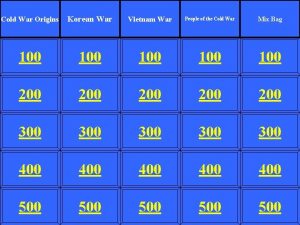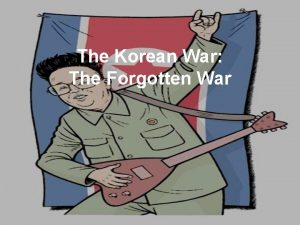Unit 7 Notes The Korean War The Korean






















- Slides: 22

Unit 7 Notes The Korean War


The Korean War I. Background A. Pre-World War II – Japan takes Korea as a colony in 1910. B. Post-World War II – After Japan Surrendered the U. S. and the Soviets divided Korea into two sectors with the U. S. controlling the southern part and the Soviets controlling the northern part. C. This division, made at the 38 th parallel was intended to be temporary.


The Korean War II. Elections A. The U. S. and the majority of the Korean people called for free elections to be held in Korea to pick a leader following Allied withdrawal. 1. The North Korean leadership refused because more than 2/3 of the population lived in Southern Korea.

The Korean War Kim Il Sung Kim Jung Il B. North Korea elected Communist leader Kim Il Sung C. South Korea elected anti-communist leader Syngman Rhee

The Korean War III. Invasion A. June 25, 1950 – North Korea stormed over the 38 th parallel with their Soviet built tanks and quickly took over South Korea. B. June 27, 1950 – with the Soviet delegates absent the U. N. Security Council voted 9 -0 to come to the aide of South Korea.

The Korean War C. The U. N. , while sending troops to beat back the North Koreans to the 38 th parallel, would be careful not to call this a war. Instead they referred to it as a “Police Action” 1. U. S. President Harry S. Truman quadrupled U. S. military spending. 2. The U. S. would soon have 3. 5 million soldiers in uniform and spend $50 billion dollars in preparation. 3. While 16 different countries sent troops to help, the majority of all ground forces were either U. S. or South Korean.

The Korean War IV. Leadership A. U. N. gives Truman the right to pick the Supreme Commander of U. N. forces. His pick = General Douglas Mac. Arthur B. By August of 1950 North Korea had captured virtually all of South Korea.

The Korean War C. Mac. Arthur planned a surprise amphibious attack behind the North Korean lines at a town called Inchon. This attack was very successful and they were able to drive the North Koreans back beyond the 38 th parallel.

The Korean War D. Although their original objective had been met, Mac. Arthur, with the support of Truman and the U. N. orders the U. N. forces to cross the 38 th parallel and continue to push the North Koreans back.

The Korean War V. Surprise A. In November of 1950 the U. N. forces had North Korean troops pushed back to the Chinese border when 300, 000 Chinese soldiers came spilling over the borders to attack the U. N. forces.

The Korean War B. U. N. forces sustained heavy casualties and where forced back over the 38 th parallel. C. Truman and others were now horrified that with the Chinese involved they may lose Korea entirely. http: //users. erols. com/mwhite 28/korea. htm

The Korean War VI. Disagreement A. President Truman now called for “limited war”. He said the U. N. should: 1. Seek specific objectives rather then complete victory. 2. Nuclear weapons should not be used. 3. An invasion of China is to be avoided at all cost.

The Korean War B. General Mac. Arthur strongly Disagreed. He said the U. N. should: 1. Accept no substitute for victory. 2. Use nuclear weapons 3. Use strong force against Chinese cities.

The Korean War C. Mac. Arthur defied President Truman and demanded the unconditional surrender of the North Koreans. What should Truman do? D. President Truman fires Mac. Arthur

The Korean War E. Mac. Arthur returns to the states a hero and the U. S. population loses interest in the war.

The Korean War VII. Negotiations A. Both sides sit down in July of 1951 to negotiate a settlement. B. The war rages on for two more years during these talks.

The Korean War C. In November of 1952 Dwight Eisenhower wins the Presidential election and vows to visit Korea to get the stalled peace talks moving again. D. After Eisenhower’s visit he threatens to use nukes if peace is not achieved.

The Korean War VIII. Cease-Fire A. July 27, 1953 an Armistice is signed. This armistice is still in effect today. 1. North & South Korea are officially separate nations divided by the 38 th Parallel. 2. A DMZ ( Demilitarized Zone ) runs along each border.

The Korean War IX. Results A. 54, 000 U. S. soldiers and 3, 000 U. N. soldiers are killed. B. 1. 5 million North Korean and Chinese soldiers killed C. 2 million civilians killed ( mostly from the South)

The Korean War D. The U. N. successfully repelled the North Korean attempt to conquer all of Korea. E. The U. S. successfully stopped the spread of communism. F. Today North Korea and its current leader Kim Jung Il Kim Jong Un pose one of the biggest threats to world peace.
 Vietnam war
Vietnam war Truman vs eisenhower venn diagram
Truman vs eisenhower venn diagram Korean war webquest
Korean war webquest What were the causes of the korean war
What were the causes of the korean war Cold war summary
Cold war summary Korean war map activity answer key
Korean war map activity answer key Finnish korean war
Finnish korean war Cause of korean war
Cause of korean war Cause of korean war
Cause of korean war American troops fight the korean war 48a answer key
American troops fight the korean war 48a answer key The korean war
The korean war Korean war map
Korean war map What were the causes of the korean war
What were the causes of the korean war Rollback cold war
Rollback cold war Causes of korean war
Causes of korean war Korean war
Korean war Korean war
Korean war Unit 10, unit 10 review tests, unit 10 general test
Unit 10, unit 10 review tests, unit 10 general test Wisc
Wisc Civil war guided notes
Civil war guided notes Second carnatic war
Second carnatic war Carnatic wars notes
Carnatic wars notes War at home and abroad madison
War at home and abroad madison


